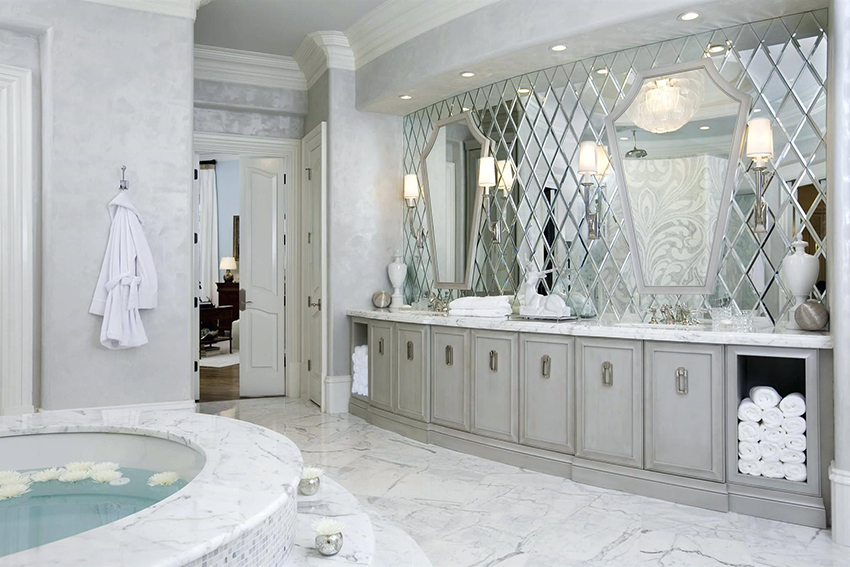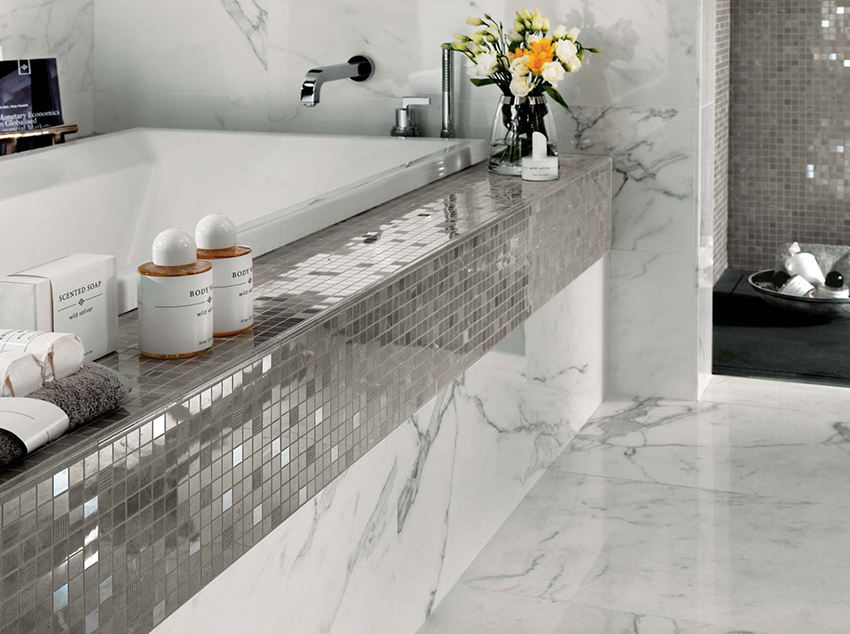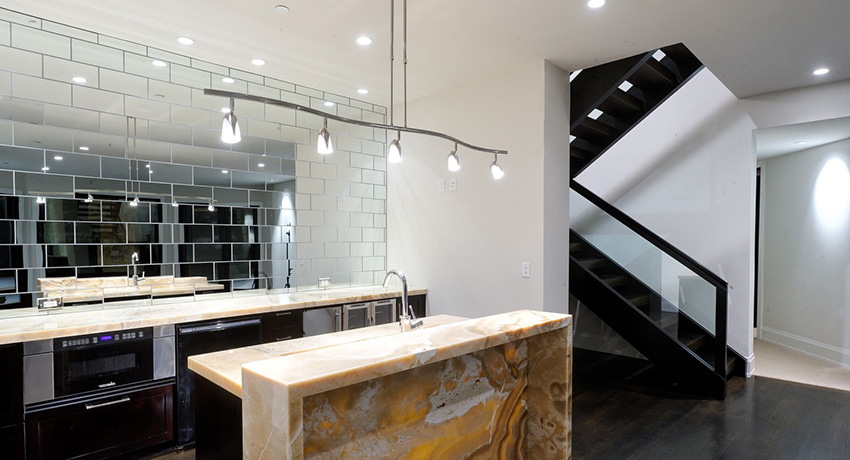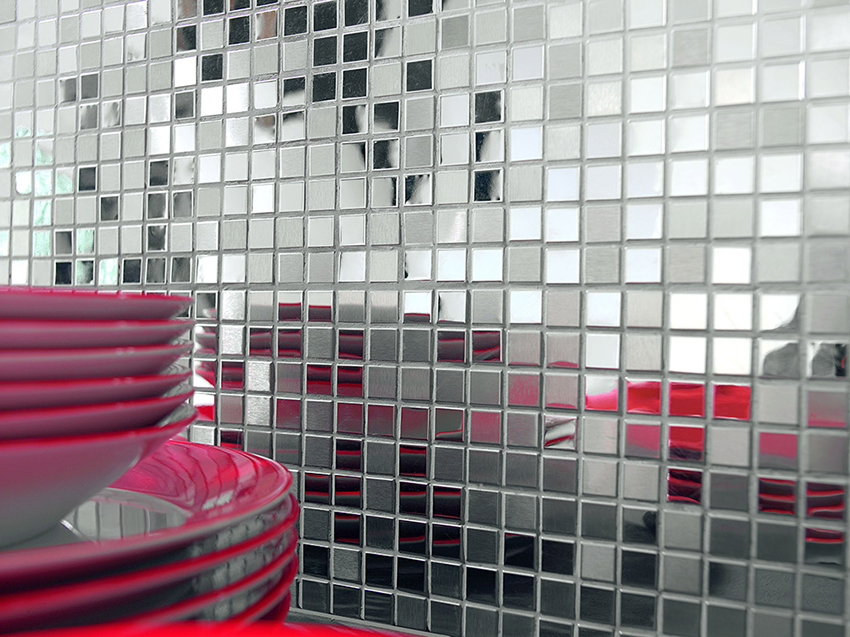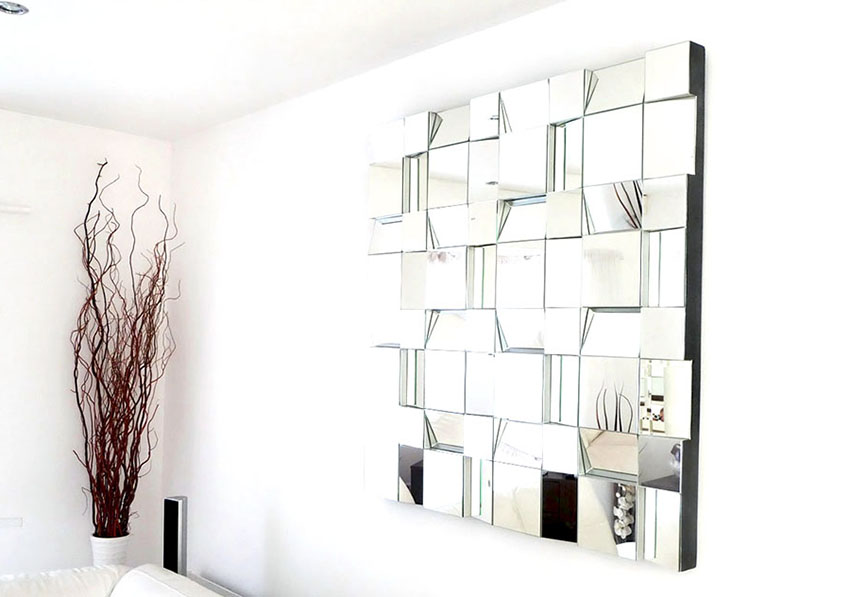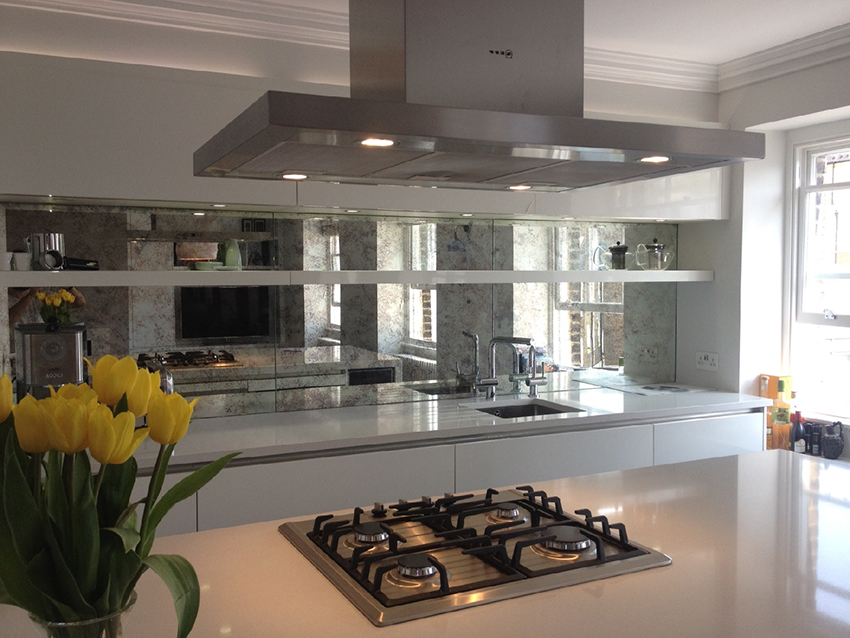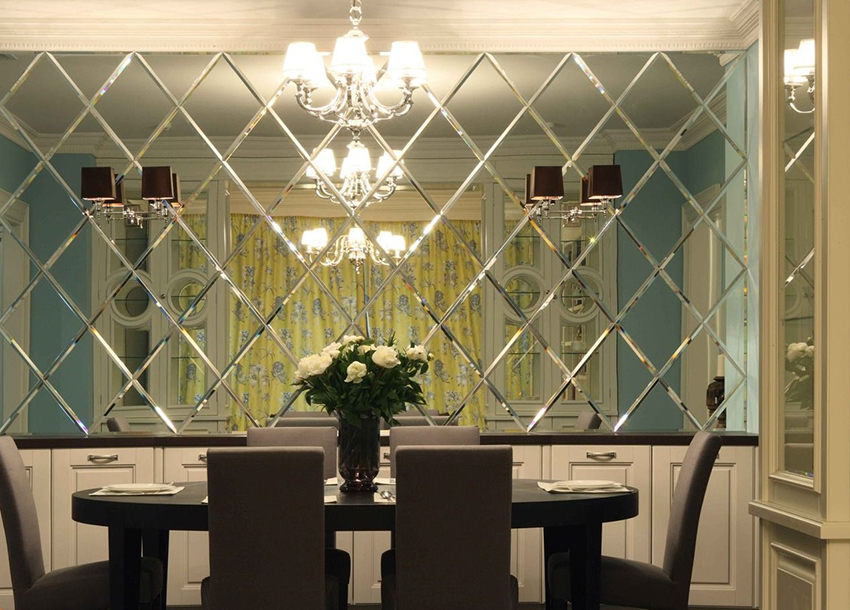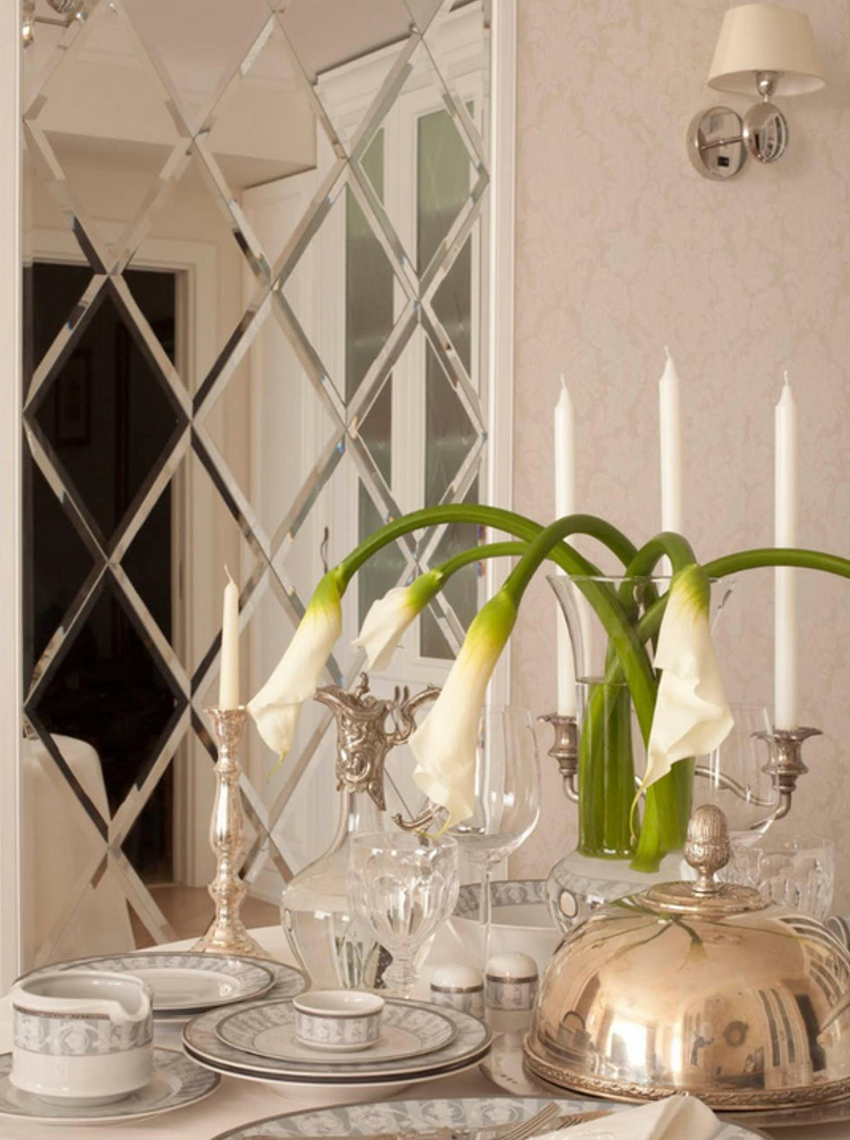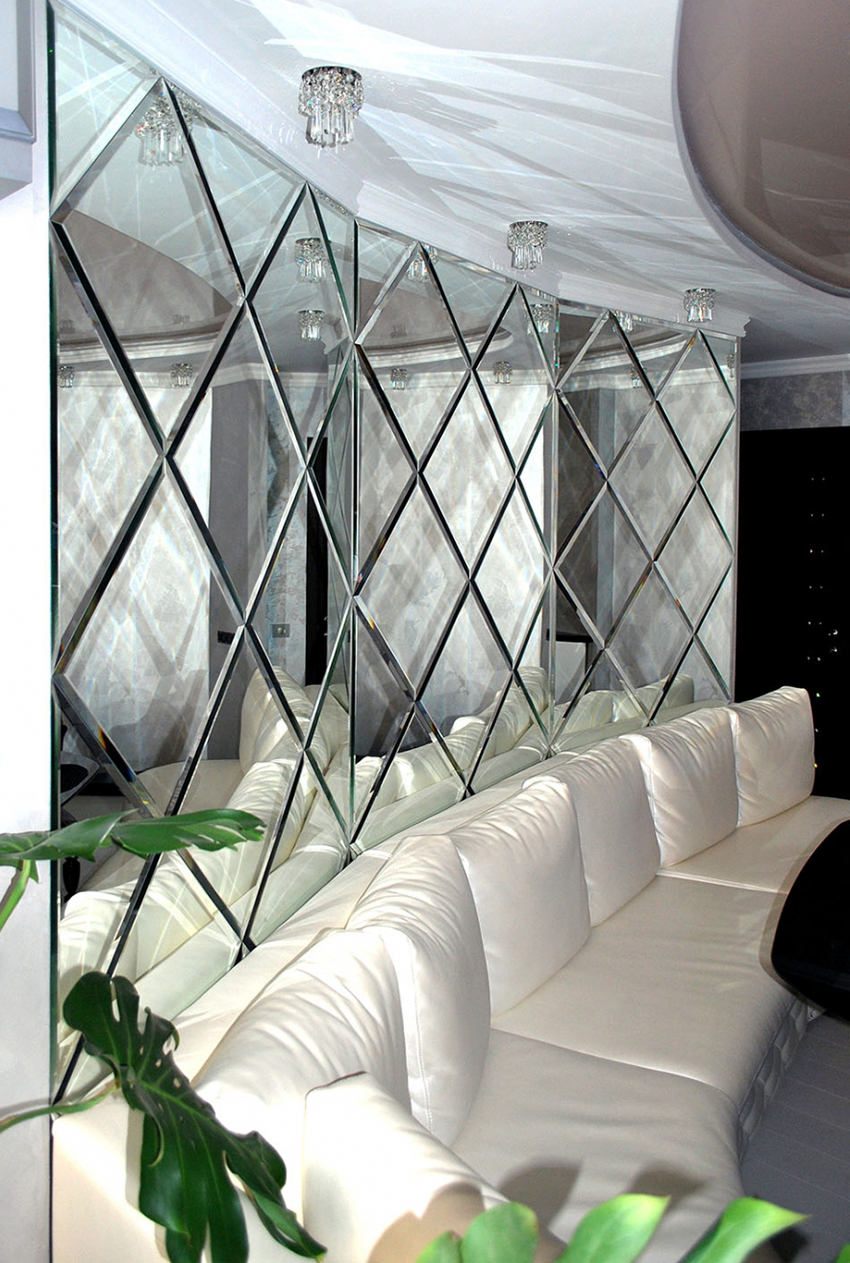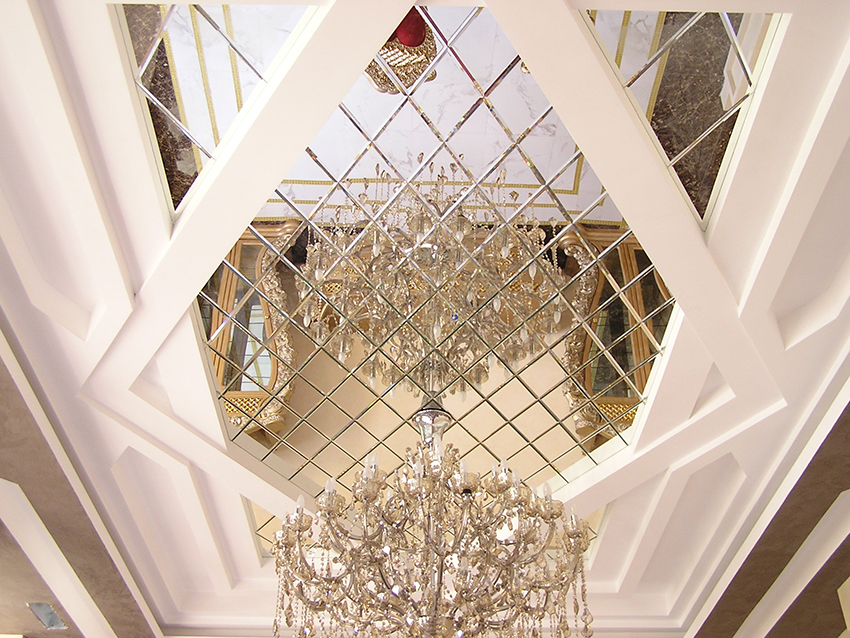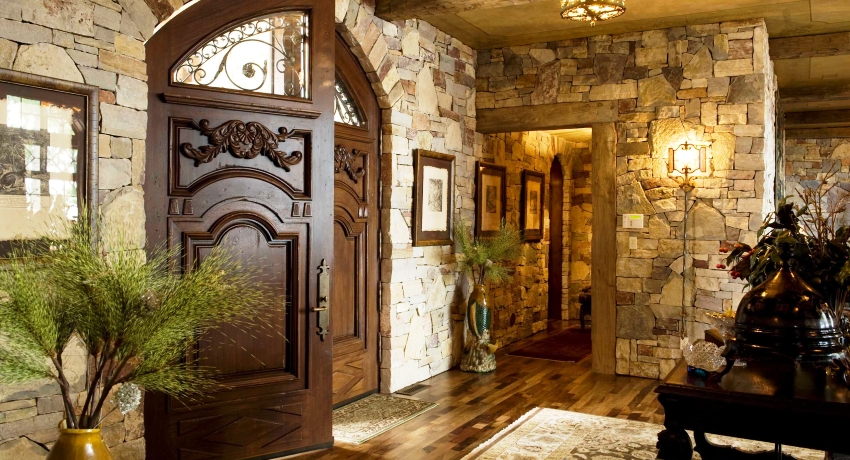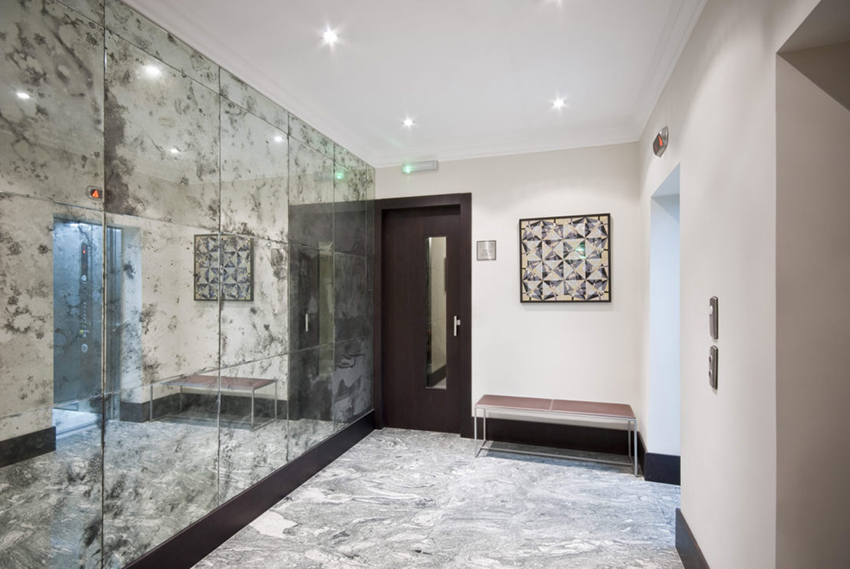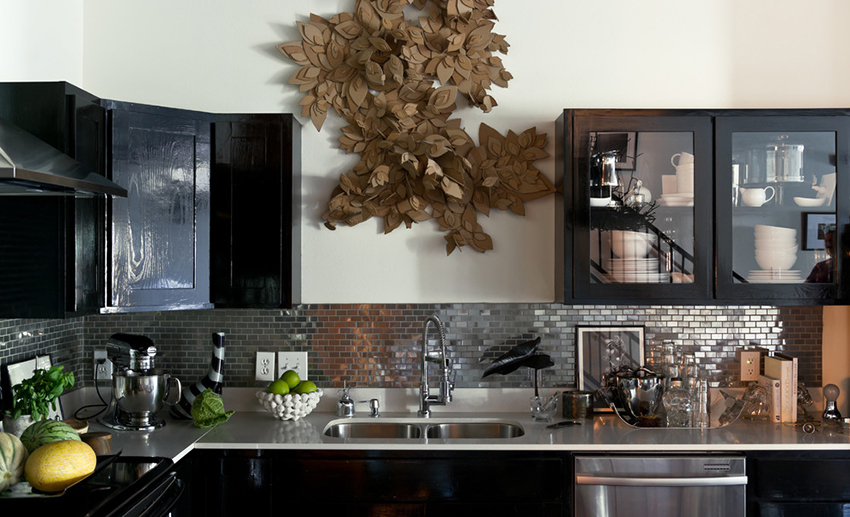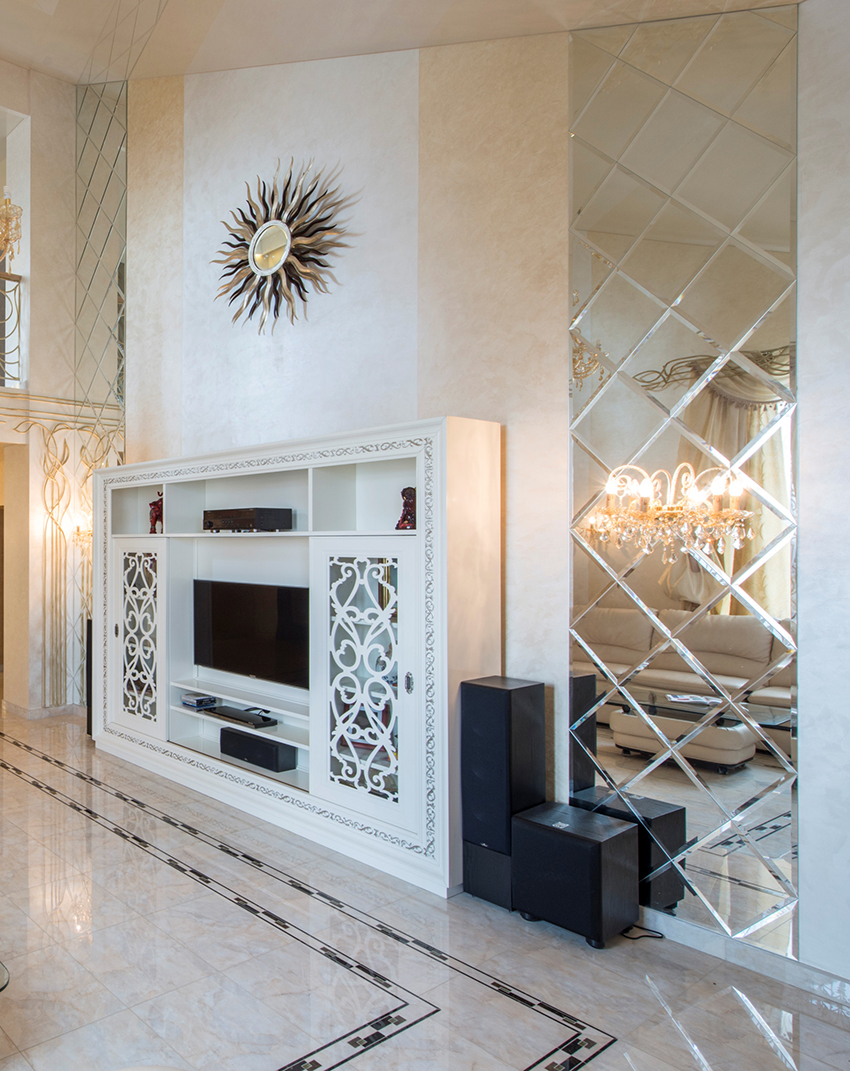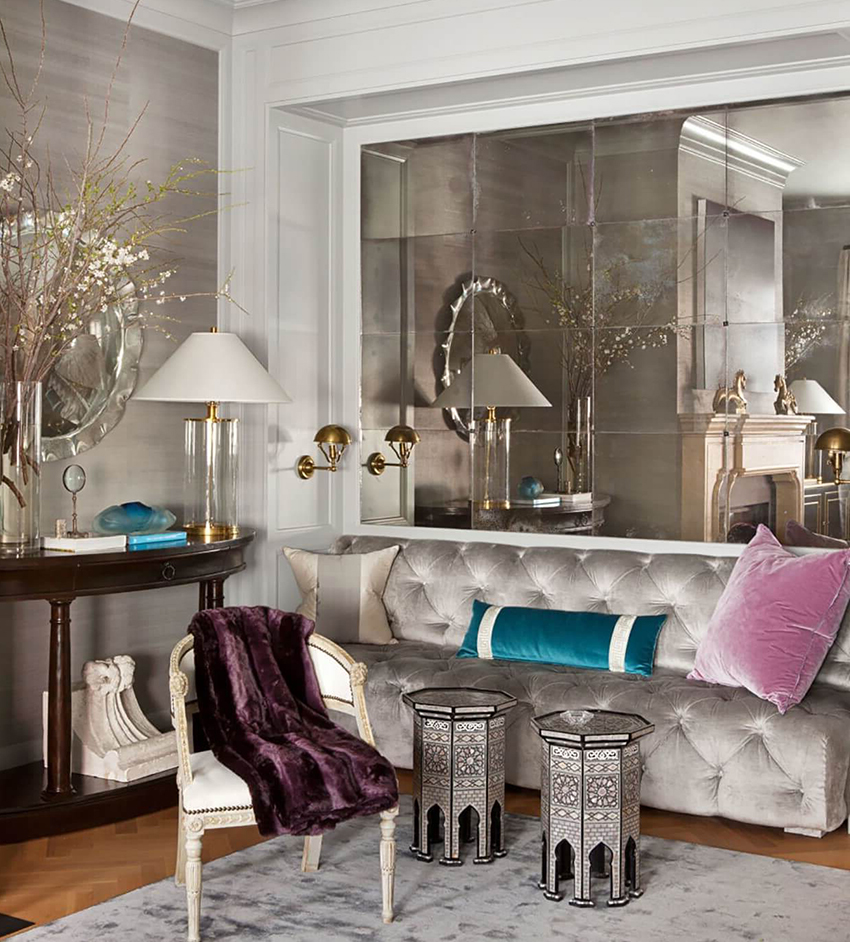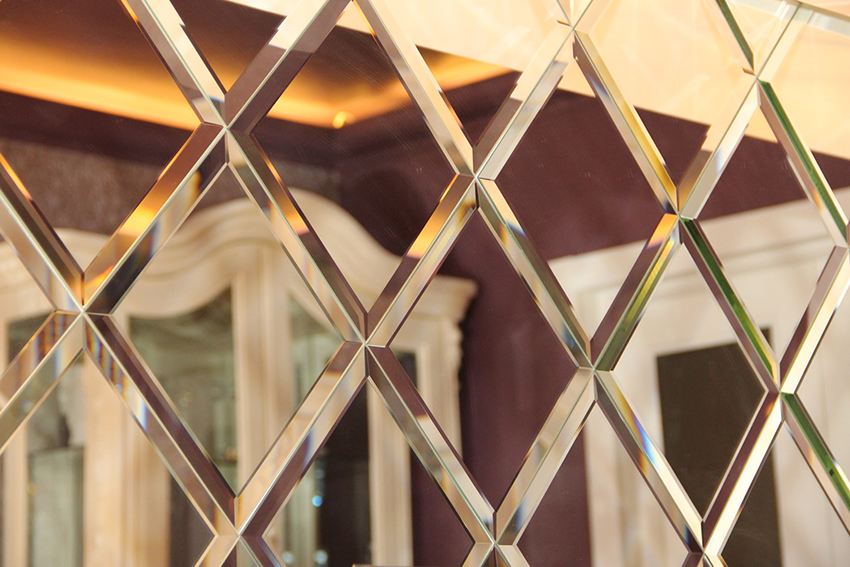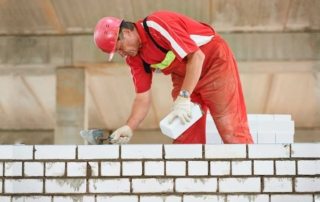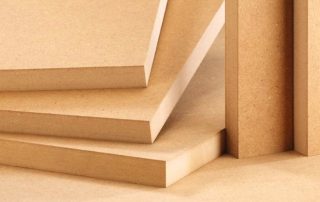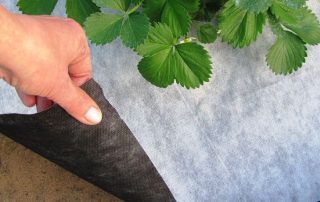Mirror tile with facet is a finishing material that immediately fell in love with many designers and craftsmen in the construction industry. The tile has an unusual appearance, due to which it can become the basis for creating a unique, mesmerizing interior. With its help, it is possible to bring to life the most unusual and creative design solutions, which, due to the high performance of the product, will delight the eyes of the owners for many years.

With the help of mirror tiles, you can create a stylish and unusual design, make the interior unique
Content [Hide]
What is beveled mirror tile
The beveled tile is represented by a small fragment of a mirror having a strictly specified shape and size, the edges of which are processed in a special way: the bevel is removed from the beveled side of the product. Such processing gives the mirror coating a more refined, graceful and unusual look, allowing to reveal new facets of the use of mirror panels.
Facet is not only a kind of security element, but also a beautiful decor. Under the sun's rays, the beveled edge begins to sparkle with all the colors of the rainbow, which looks very stylish and beautiful. The maximum effect is achieved for panels with a wide bevel. The narrow edge makes the tile look more elegant and neat.
The manufacturing process of products is presented not just by ordinary sharp mirrors, but involves the use of jamming technology. During the production of mirror tiles, the price of which depends on the size and type of the product, special mufflers are introduced, represented by amorphous, gaseous or crystalline compounds. It is these components that give the final product the necessary transparency that is characteristic of a traditional mirror. The material is not delicate and fragile. It is quite difficult to damage it.
Advantages and disadvantages of mirrored beveled tiles
Facet mirror tiles on the wall have clear advantages along with other facing materials. Having a special design, the one-piece structure of faceted tiles is more resistant to moisture and temperature influences than a simple mirror.This affects the life of the product. The tile does not come into contact with alkalis and acids, therefore, when cleaning it with various aggressive detergents, the product will not lose its original operational and aesthetic properties.
Due to its outstanding appearance, which can be favorably emphasized by various tile laying techniques, you can get unusual options for a mirror panel on the wall. The price of the composition will be determined by the number and type of tiles. Such tiles will allow you to create a unique interior of the room, visually expanding its spaciousness.
Along with the advantages of the product, some disadvantages of the tile should be pointed out. Each element is quite fragile. The material requires careful and accurate transportation so that it does not crumble, break or scratch during transportation. Over time, the surface of the tiles may darken. This problem can be avoided with the help of a properly installed efficient ventilation system.
Another disadvantage is the high cost of the products. This is due to the fact that the manufacture of tiles requires the use of high-tech devices and expensive additional components.
Varieties of mirrored tiles with facet
Today, manufacturers produce a wide range of beveled mirror tiles, which can be bought in various shapes and sizes. The most popular option is the square, it is easiest to lay it and combine it with other materials for finishing the room. A kind of square is a rhombus. Thanks to the diagonal stacking of products, an interesting and unusual mirror panel is obtained. Rectangular elements are also popular. They can be laid out, imitating brickwork with an offset, or arranged in a checkerboard pattern.
There are other forms of the product, made in the form of a trapezoid, polygon, triangle, circle or oval. However, such tiles are usually made to order. A mirror panel made of elements of an unconventional shape requires more laborious installation.
Mirror tiles can have dimensions from 100x100 mm to 500x500 mm. The most popular of them are: 150x150, 200x200, 250x250 and 300x300 mm. The size of the facet in it can range from 10-30 mm. You can buy mirror tiles from 170 rubles / piece. The smaller the dimensions of the product, the more elegant the mirror panel is, formed by a certain number of elements. The thickness of products is usually 4 mm, but there are also more massive options with a thickness of up to 10 mm.
Particularly noteworthy is the mirror mosaic... The tile is represented by a tiny square with edges that, reflecting rays of light, shimmer with rainbow colors. The sizes of the chips are 10x15, 20x20, 20x42, 50x50 mm, they are fixed on a flexible mesh base at a distance of about 2 mm from each other. Typically these tiles are used in combination with regular sized items. From it, you can create unusual panels or arrange an area around a lamp, mirror or cabinet.
Material of manufacture and appearance of mirror products
Facet tiles can be made of glass, plastic or polyurethane with a special reflective coating. The first option is the most common. In addition to standard elements, it is possible to produce custom-made products of an individual size and desired shape, having an original edge shape. The most popular option is Russian-made DST mirror tiles, which are presented in a wide range.
The appearance of polyurethane tiles is similar to a mirror surface, but it has a less distinct and clear reflection. In comparison with glass products, such material has less weight, which facilitates further installation. The tile is mainly used for ceiling cladding. The cheapest option is acrylic mirror products.
The most common product is colorless mirror tiles, which will suit any interior. Mirror panels with a facet made of tinted glass for gold or bronze will look spectacular and unusual. There are options, painted in different colors: blue, green, dark gray, red, beige, olive and blue. Colored tiles can be used as an independent element or combined with a colorless material.
Photos of mirror tiles clearly display a wide range of products; it can be plain or ornamented. Its surface can be applied with an abstract pattern, a drawing by sandblasting or using thermal printing.
Mirror tiles in the interior: photos of design solutions
Facet tiles with a mirror surface can be used both to fill large areas and to create a spectacular panel that can be limited by frames or borders. Such niches should definitely be refined with lamps in order to get the maximum effect from the play of light in the room. You can create a mirror composition yourself from individual elements or order a ready-made mirror panel with a facet, which can be bought from 8 thousand rubles. depending on the version.
Important! The use of mirror surfaces in the interior should be carried out with a sense of proportion. Otherwise, an excessive amount of it can negatively affect the nervous system.
Since mirrors visually enlarge the space and saturate the room with additional light, the use of faceted tiles is especially important for small rooms. Inserts made from different types of products, but of the same size, will look unusual and bold. This material can be combined with ceramic tiles in dark shades, which in combination will allow you to recreate the illusion of depth in space. Mirror panels on the wall also look spectacular, the photos clearly display various options, which are framed by a silver or white frame.
A good solution is a combination of areas finished with mirror elements with different degrees of reflection, which should be at different levels relative to the observation site.
Helpful advice! It is recommended to use matte or LED lamps as light sources that will be reflected in mirrored surfaces. They will not have a negative effect on a person's vision, making him tired.
Mirror tiles with facet are a versatile finishing material that can be used in the decor of any room. Thanks to its inherent extravagance, grace, elegance and boldness, it fits well into any style of interior design.
Options for using mirrored tiles with a facet
Products can be laid not only on the walls, but also on the ceiling, thereby creating unlimited space, as the photos of mirror tiles in the bathroom clearly show. In this case, wall tiles can be patterned, and smooth products with a subtle color tint can be used on the ceiling.
Mirrored ceiling tiles visually raise the room, increasing its height. However, in this case, the effect of an inverted room is achieved at the same time. This is especially noticeable when the entire ceiling area is laid out with mirror tiles. For the best effect, the mirror panel laid out with facet tiles, the photo clearly displays this, should take up a small part of the space. An important point in this case is what will be reflected in the mirrored ceiling. In this case, special requirements are imposed on the flooring.
The use of mirrored tiles on the ceiling is justified only for small rooms. When decorating the interior of large rooms with high ceilings, this elevated effect will fill the room with emptiness and cold.
Helpful advice! With the help of tiles, you can also decorate the doors of wardrobes in the hallway or room.
Mirror tiles are rarely used for flooring. In this case, the interior should be thought out to the smallest detail so as not to create a negative effect on what will be reflected in the mirror. In a room with a mirrored floor, it is not recommended to use other mirrored surfaces.
Related article:
Decorative stone in the interior: stylish home decoration
Advantage of use, types of materials for interior decoration, decor options for different rooms with photo examples and ideas.
Facet tiles for hallway and bathroom interior decoration
A very expedient solution is the location of the mirror tiles in the hallway. Here it is appropriate to create a reflective panel on one of the walls, where a person will see himself in full growth. A narrow and long room can be adjusted by finishing the side walls with mirror tiles, which can be combined with other finishing materials.
Mirror tiles are appropriate to use when decorating walk-through areas that are not always sufficiently illuminated. The original option is to lay faceted tiles on the riser, as a result of which the staircase acquires lightness and soars in the air.
Mirrored tiles any surface can be coated in the bathroom. This is due to the fact that the material is highly resistant to moisture. Mirror surfaces will visually expand the space of the room, making it lighter. This is especially important for small spaces.
Most often, mirror tiles for the bathroom are located above the sink and on the wall near the bathroom. A mirror panel made of harmoniously combined products of different types, but of the same size, will look stylish and unusual.
If the bathroom has a screen, it can be decorated with mosaic tiles that are resistant to mechanical damage and scratches.
Helpful advice! To highlight the refraction of light in each fragment of the mirror panel; it is recommended to mount spot lighting in the room.
Mirror panel from tiles in the design of the kitchen
The kitchen, the interior of which is decorated with mirrors on the walls and ceiling, will look expensive and stylish. This material is used to create classic, baroque and empire interior designs. Thanks to the play of light and glare, which are reflected in the mirrors, an elevated, solemn mood is created.
It is very important not to overdo it with mirrors in the kitchen, the photos clearly reflect the negative effect of mirror surfaces. In this regard, it is not recommended to place mirror surfaces opposite each other, which will significantly overload the room. Even if mirror panels are decorated on opposite sides, they should not be reflected in each other, as this will create additional discomfort.
Mirror tiles in the kitchen can be found when decorating an apron - the surface between the countertop and the cabinets of the upper tier. However, such a panel will quickly become dirty from splashing water and oily deposits. Such a surface needs regular cleaning. The mirror surface also looks good in the dining area.
Mirror tiles in the bedroom and living room
Mirror tiles have proven themselves well in the interior of the living room. With its help, you can zone the room. This is a good solution in combination with a multilevel ceiling. You can also lay out one of the walls of the room with facet tiles, which will visually expand its dimensions and emphasize the interior details. Here you can use tiles with engraving, painting or patterns on the surface of the products.
For the living room, a good solution is to make a mirrored ceiling, which can be framed with gilded baguettes. Only the area around the chandelier should be covered with tiles on the ceiling, which is clearly shown in the photo of a mirror panel, which can be bought for 4-5 thousand rubles. Glare of light reflected in the mirrored surface will increase the room's illumination level.
Helpful advice! For a living room decorated with mirrored surfaces, it is recommended to use furniture and decor elements made of genuine leather, wood and fabric.
Another good design solution is to use the property of the mirror to double objects located next to it. Near the mirrored wall, you can put several flowerpots with indoor flowers or beautiful glassware, the amount of which will double in the mirror image, which is clearly demonstrated by photos of mirror tiles in the living room interior.
Helpful advice! Mirrored tiles you should decorate the part of the wall near which the most beautiful piece of furniture or decor is located.
When decorating a bedroom interior, it is not recommended to place mirror tiles opposite the bed and on the ceiling. This will create some discomfort and embarrassment. In the bedroom, it is better to place a mirror panel at the head of the bed or create two inserts above the bedside tables.
Technology of laying a mirror panel on the wall
Before you start laying the tiles, you should prepare the base: plaster all the irregularities, level the surface and cover it with a primer. This is an extremely important step, since the slightest deviation will negatively affect the reflective effect of the tile. Installation of products is carried out using silicone, liquid nails or cement-sand mortar.
Helpful advice! For better adhesion of the tile to the surface, coarse sand is added to the liquid adhesive.
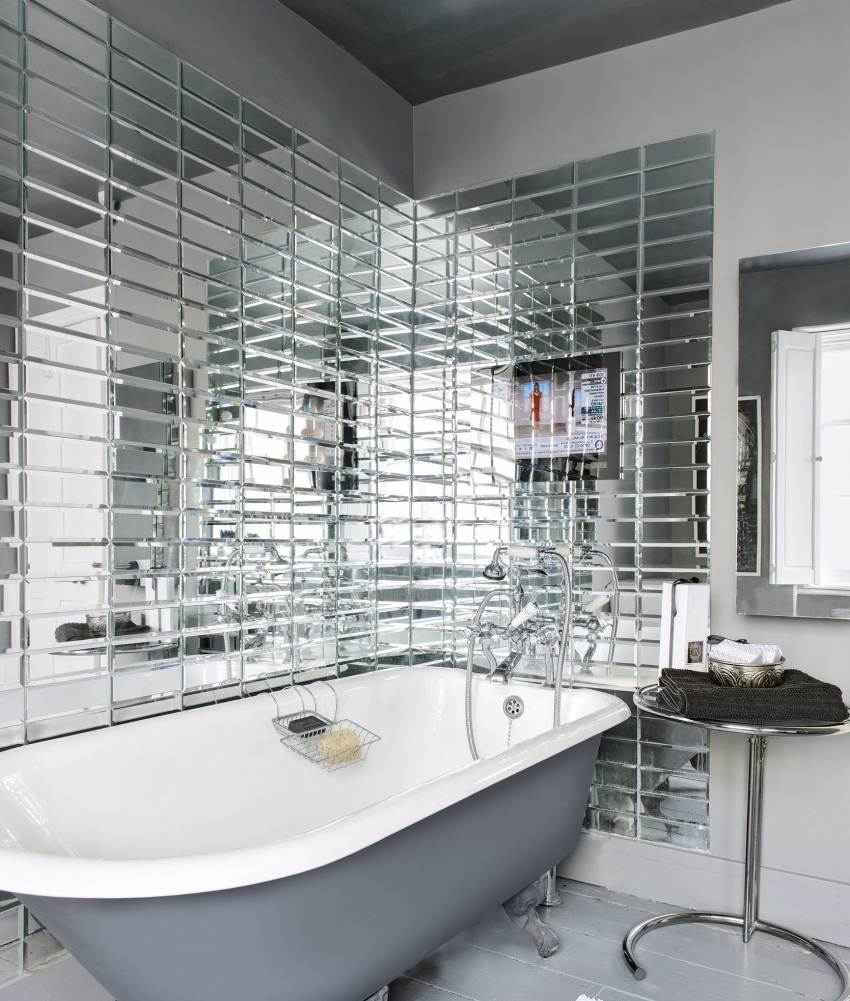
In order for the tile to shine and not lose its original appearance, it must be polished with a special tool
The size and number of tiles is selected according to the developed sketch of the future panel. In this case, the possibility of cutting the products should be excluded, since this is a very complex process, which can lead to significant material consumption associated with damage during cutting.
Mirror tile panels are laid from the lower horizontal row. Gaps of no more than 3-4 mm should be left between the products in order to compensate for the error regarding the uniformity of the sides of the tile. The width of the gap is adjusted using crosses of the required size.
Complete drying of the surface occurs in 4-5 days, after which the grouting is carried out using silicone, excluding the presence of acids in its composition.After the grout is completely dry, you can start polishing the surface with a microfiber cloth and a mirror cleaner.
Caring for a mirror panel is not a difficult or time-consuming process. It is enough to periodically process the tile with a special tool and wipe it with a rag, polishing the product. Thanks to this care, it will be possible to preserve the original shine and mirror effect of the surface for a long time.
With the help of beveled mirror tiles, you can bring to life bold design solutions, thanks to which the room will acquire a stylish, sophisticated and luxurious look, and will delight the eyes of the owners for many years.

